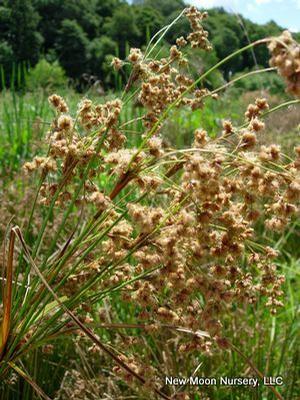Printed at http://www.newmoonnursery.com/index.cfm/

Green bulrush has rhizomatous and fibrous roots, making it a good soils stabilizer. This wetland species is a cool season grass.
Scirpus atrovirens
Green bulrush
Native to North America
FIRST IMPRESSIONS: Scirpus atrovirens is a rhizomatous cool season perennial sedge relative. Plants produce multiple culms with arching or drooping olive green leaves. In summer, fertile culms bear rounded yellow-green compound inflorescences followed by deep brown achenes. This contender is much too aggressive for small manicured gardens. Instead the tenacious roots and rhizomes are a boon for expansive wetland restoration projects and soggy sites with erosion issues.
HABITAT & HARDINESS: Scirpus atrovirens occurs from Newfoundland to Manitoba and throughout most of the contiguous United States. The species is absent from Florida and 7 western states and is most abundant in the Northeast and Midwest.
Habitats include wet to moist prairies, sedge meadows, marshes, seeps, bogs, swamps, sloughs, open floodplain forests, low ground along creeks and rivers, moisture retentive right of ways and drainage ditches. This species is a widely distributed freshwater wetland species that is often found in disturbed or degraded wetlands.
This species is hardy from USDA Zones 3-9.
PLANT DESCRIPTION: Scirpus atrovirens is an unbranched tufted perennial with short thick rhizomes. This cool season plant actively grows during cooler spring and fall weather.
Plants have green triangular upright culms with 8 or so alternate leaves. Blades are 18” long and ¾” across with yellow-green to dark green color. They are linear with a furrowed midrib, rough textured edge and prominent green or brown sheaths.
In summer, fertile culms are topped by a cluster of compound umbels with 3 or more spreading leafy bracts beneath. The umbels consist of green ovoid spikelets that are less than ¼” long.
In autumn foliage develops soothing gold and brown highlights. The spikelets mature into bristly chocolate brown achenes arranged in starry rounded clusters. The seed display persists until the end of the growing season.
Plants are 3-4’ tall with 2-4’ spread.
CULTURAL & MAINTENANCE NEEDS: Scirpus atrovirens prospers in sunny moist or wet sites. During establishment plugs or seedlings require full sun and wet conditions. Well rooted rhizomes, however, can migrate into moist lightly shaded woodlands.
Plants thrive in standing water up to 1’ deep and in acid to slightly alkaline saturated soils. They develop yellow leaves and usually decline in dense shade or during drought.
This species readily self-sows and increases by rhizomes. In disturbed wet sites plants are valued for their ability to bind soil and prevent erosion. This assertive expansion and tenacious nature causes plants to be too aggressive for most garden situations. Avoid planting in sites with limited space and vulnerable slow growing companions.
LANDSCAPE USES: Scirpus atrovirens is most valuable for Restoration Projects, Erosion Control, large Water Gardens and Stormwater Management projects. Plants are often installed as part of a Grouping or Mass in Wetland situations.
COMPANION & UNDERSTUDY PLANTS: Try pairing with Anemone canadensis, Carex muskingumensis, Carex stricta, Iris versicolor or Juncus effusus.
Carex comosa has similar cultural needs and can be substituted if needed.
TRIVIA: Described in Botanical writings as cespitose or “Having the form of a piece of turf, i.e. many stems from one rootstock or from many entangled … roots”.
Even though Scirpus atrovirens is in the sedge family, Scirpus is the old Latin word for “bulrush”.
The seeds are a good food for ducks, rails and other wetland birds. Plants are considered deer resistant.
Height:
3-4 ftSpread:
2-4 ftSpacing:
3-4 ftUSDA Hardiness Zone:
3-9Bloom Color:
Green, TanScirpus atrovirens Characteristics
Attributes
- Rain Garden
- Dried Flower
- Naturalizing
Exposure
- Full Sun to Partial Shade
Flowering Months
- September
- August
- July
- June
Foliage Color
- Green
Grass Season
- Cool Season Grass
Salt Tolerance
- Medium
Season of Interest (Foliage)
- Fall
- Summer
- Spring
- Winter
Soil Moisture Preference
- Wet to Moist
Interesting Notes:
For more information on this plant, visit the USDA PLANTS Database: http://plants.usda.gov/java/profile?symbol=SCAT2
